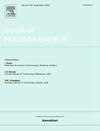通用球床反应器(GPBR-200)磨合过程参数研究
IF 2.3
3区 工程技术
Q1 NUCLEAR SCIENCE & TECHNOLOGY
引用次数: 0
摘要
球床反应堆的磨合期复杂且难以建模,因为堆芯组成、功率和温度具有显著的非均质性。虽然初始堆芯组成最终会产生相同的平衡堆芯组成,但达到平衡的方法可能会因启动燃料富集度和功率斜坡率等因素而发生显著变化。为了探索这一点,我们使用了通用卵石床反应堆的高保真模型来改变功率斜坡方案和启动堆芯组成。初始岩心组成和功率斜坡速率对早期时间步长鹅卵石的流动速率都有显著影响,较高的斜坡速率和较低的富集程度导致了非物理流动速率。研究发现,在磨合过程中,仅功率斜坡率就决定了观察到的最大卵石功率峰值,较高的斜坡率导致更高的卵石功率峰值。启动燃料浓缩和功率爬坡都影响总燃料消耗,尽管启动燃料浓缩的影响通常次于爬坡率。本文章由计算机程序翻译,如有差异,请以英文原文为准。
Parameter study of the running-in process for the Generic Pebble Bed Reactor (GPBR-200)
The run-in period of a pebble-bed reactor is complex and difficult to model given significant heterogeneity in core composition, power, and temperature. While the initial core composition should eventually result in the same equilibrium core composition, the approach to equilibrium can vary significantly depending on factors such as startup fuel enrichment and power ramp rate. To explore this, we used a high-fidelity model of the General Pebble Bed Reactor to vary power ramp schemes and startup core compositions. Both the initial core composition and power ramp rate had a significant impact on the flow rate of pebbles during early time steps, with higher ramp rates and low enrichment resulting in non-physical flow rates. Power ramp rate alone was found to dictate the maximum pebble power peaking observed during the run-in process, with higher ramp rates resulting in greater peak pebble powers. Startup fuel enrichment and power ramp were found to both impact total fuel consumption, although the impact of startup fuel enrichment was generally secondary to ramp rate.
求助全文
通过发布文献求助,成功后即可免费获取论文全文。
去求助
来源期刊

Annals of Nuclear Energy
工程技术-核科学技术
CiteScore
4.30
自引率
21.10%
发文量
632
审稿时长
7.3 months
期刊介绍:
Annals of Nuclear Energy provides an international medium for the communication of original research, ideas and developments in all areas of the field of nuclear energy science and technology. Its scope embraces nuclear fuel reserves, fuel cycles and cost, materials, processing, system and component technology (fission only), design and optimization, direct conversion of nuclear energy sources, environmental control, reactor physics, heat transfer and fluid dynamics, structural analysis, fuel management, future developments, nuclear fuel and safety, nuclear aerosol, neutron physics, computer technology (both software and hardware), risk assessment, radioactive waste disposal and reactor thermal hydraulics. Papers submitted to Annals need to demonstrate a clear link to nuclear power generation/nuclear engineering. Papers which deal with pure nuclear physics, pure health physics, imaging, or attenuation and shielding properties of concretes and various geological materials are not within the scope of the journal. Also, papers that deal with policy or economics are not within the scope of the journal.
 求助内容:
求助内容: 应助结果提醒方式:
应助结果提醒方式:


